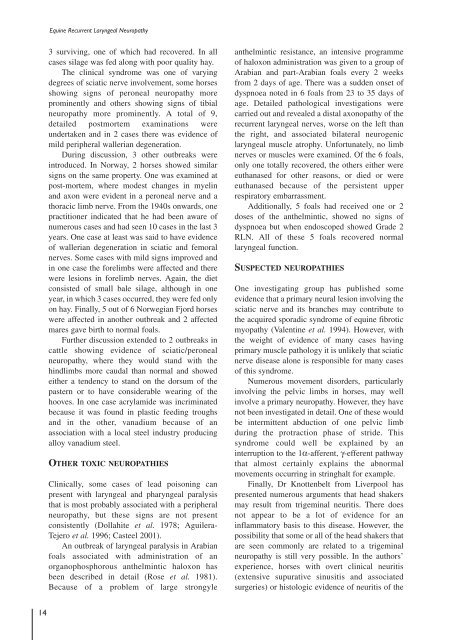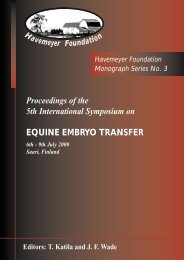Proceedings of a Workshop on - The Havemeyer Foundation
Proceedings of a Workshop on - The Havemeyer Foundation
Proceedings of a Workshop on - The Havemeyer Foundation
You also want an ePaper? Increase the reach of your titles
YUMPU automatically turns print PDFs into web optimized ePapers that Google loves.
Equine Recurrent Laryngeal Neuropathy<br />
3 surviving, <strong>on</strong>e <str<strong>on</strong>g>of</str<strong>on</strong>g> which had recovered. In all<br />
cases silage was fed al<strong>on</strong>g with poor quality hay.<br />
<strong>The</strong> clinical syndrome was <strong>on</strong>e <str<strong>on</strong>g>of</str<strong>on</strong>g> varying<br />
degrees <str<strong>on</strong>g>of</str<strong>on</strong>g> sciatic nerve involvement, some horses<br />
showing signs <str<strong>on</strong>g>of</str<strong>on</strong>g> per<strong>on</strong>eal neuropathy more<br />
prominently and others showing signs <str<strong>on</strong>g>of</str<strong>on</strong>g> tibial<br />
neuropathy more prominently. A total <str<strong>on</strong>g>of</str<strong>on</strong>g> 9,<br />
detailed postmortem examinati<strong>on</strong>s were<br />
undertaken and in 2 cases there was evidence <str<strong>on</strong>g>of</str<strong>on</strong>g><br />
mild peripheral wallerian degenerati<strong>on</strong>.<br />
During discussi<strong>on</strong>, 3 other outbreaks were<br />
introduced. In Norway, 2 horses showed similar<br />
signs <strong>on</strong> the same property. One was examined at<br />
post-mortem, where modest changes in myelin<br />
and ax<strong>on</strong> were evident in a per<strong>on</strong>eal nerve and a<br />
thoracic limb nerve. From the 1940s <strong>on</strong>wards, <strong>on</strong>e<br />
practiti<strong>on</strong>er indicated that he had been aware <str<strong>on</strong>g>of</str<strong>on</strong>g><br />
numerous cases and had seen 10 cases in the last 3<br />
years. One case at least was said to have evidence<br />
<str<strong>on</strong>g>of</str<strong>on</strong>g> wallerian degenerati<strong>on</strong> in sciatic and femoral<br />
nerves. Some cases with mild signs improved and<br />
in <strong>on</strong>e case the forelimbs were affected and there<br />
were lesi<strong>on</strong>s in forelimb nerves. Again, the diet<br />
c<strong>on</strong>sisted <str<strong>on</strong>g>of</str<strong>on</strong>g> small bale silage, although in <strong>on</strong>e<br />
year, in which 3 cases occurred, they were fed <strong>on</strong>ly<br />
<strong>on</strong> hay. Finally, 5 out <str<strong>on</strong>g>of</str<strong>on</strong>g> 6 Norwegian Fjord horses<br />
were affected in another outbreak and 2 affected<br />
mares gave birth to normal foals.<br />
Further discussi<strong>on</strong> extended to 2 outbreaks in<br />
cattle showing evidence <str<strong>on</strong>g>of</str<strong>on</strong>g> sciatic/per<strong>on</strong>eal<br />
neuropathy, where they would stand with the<br />
hindlimbs more caudal than normal and showed<br />
either a tendency to stand <strong>on</strong> the dorsum <str<strong>on</strong>g>of</str<strong>on</strong>g> the<br />
pastern or to have c<strong>on</strong>siderable wearing <str<strong>on</strong>g>of</str<strong>on</strong>g> the<br />
hooves. In <strong>on</strong>e case acrylamide was incriminated<br />
because it was found in plastic feeding troughs<br />
and in the other, vanadium because <str<strong>on</strong>g>of</str<strong>on</strong>g> an<br />
associati<strong>on</strong> with a local steel industry producing<br />
alloy vanadium steel.<br />
OTHER TOXIC NEUROPATHIES<br />
Clinically, some cases <str<strong>on</strong>g>of</str<strong>on</strong>g> lead pois<strong>on</strong>ing can<br />
present with laryngeal and pharyngeal paralysis<br />
that is most probably associated with a peripheral<br />
neuropathy, but these signs are not present<br />
c<strong>on</strong>sistently (Dollahite et al. 1978; Aguilera-<br />
Tejero et al. 1996; Casteel 2001).<br />
An outbreak <str<strong>on</strong>g>of</str<strong>on</strong>g> laryngeal paralysis in Arabian<br />
foals associated with administrati<strong>on</strong> <str<strong>on</strong>g>of</str<strong>on</strong>g> an<br />
organophosphorous anthelmintic halox<strong>on</strong> has<br />
been described in detail (Rose et al. 1981).<br />
Because <str<strong>on</strong>g>of</str<strong>on</strong>g> a problem <str<strong>on</strong>g>of</str<strong>on</strong>g> large str<strong>on</strong>gyle<br />
anthelmintic resistance, an intensive programme<br />
<str<strong>on</strong>g>of</str<strong>on</strong>g> halox<strong>on</strong> administrati<strong>on</strong> was given to a group <str<strong>on</strong>g>of</str<strong>on</strong>g><br />
Arabian and part-Arabian foals every 2 weeks<br />
from 2 days <str<strong>on</strong>g>of</str<strong>on</strong>g> age. <strong>The</strong>re was a sudden <strong>on</strong>set <str<strong>on</strong>g>of</str<strong>on</strong>g><br />
dyspnoea noted in 6 foals from 23 to 35 days <str<strong>on</strong>g>of</str<strong>on</strong>g><br />
age. Detailed pathological investigati<strong>on</strong>s were<br />
carried out and revealed a distal ax<strong>on</strong>opathy <str<strong>on</strong>g>of</str<strong>on</strong>g> the<br />
recurrent laryngeal nerves, worse <strong>on</strong> the left than<br />
the right, and associated bilateral neurogenic<br />
laryngeal muscle atrophy. Unfortunately, no limb<br />
nerves or muscles were examined. Of the 6 foals,<br />
<strong>on</strong>ly <strong>on</strong>e totally recovered, the others either were<br />
euthanased for other reas<strong>on</strong>s, or died or were<br />
euthanased because <str<strong>on</strong>g>of</str<strong>on</strong>g> the persistent upper<br />
respiratory embarrassment.<br />
Additi<strong>on</strong>ally, 5 foals had received <strong>on</strong>e or 2<br />
doses <str<strong>on</strong>g>of</str<strong>on</strong>g> the anthelmintic, showed no signs <str<strong>on</strong>g>of</str<strong>on</strong>g><br />
dyspnoea but when endoscoped showed Grade 2<br />
RLN. All <str<strong>on</strong>g>of</str<strong>on</strong>g> these 5 foals recovered normal<br />
laryngeal functi<strong>on</strong>.<br />
SUSPECTED NEUROPATHIES<br />
One investigating group has published some<br />
evidence that a primary neural lesi<strong>on</strong> involving the<br />
sciatic nerve and its branches may c<strong>on</strong>tribute to<br />
the acquired sporadic syndrome <str<strong>on</strong>g>of</str<strong>on</strong>g> equine fibrotic<br />
myopathy (Valentine et al. 1994). However, with<br />
the weight <str<strong>on</strong>g>of</str<strong>on</strong>g> evidence <str<strong>on</strong>g>of</str<strong>on</strong>g> many cases having<br />
primary muscle pathology it is unlikely that sciatic<br />
nerve disease al<strong>on</strong>e is resp<strong>on</strong>sible for many cases<br />
<str<strong>on</strong>g>of</str<strong>on</strong>g> this syndrome.<br />
Numerous movement disorders, particularly<br />
involving the pelvic limbs in horses, may well<br />
involve a primary neuropathy. However, they have<br />
not been investigated in detail. One <str<strong>on</strong>g>of</str<strong>on</strong>g> these would<br />
be intermittent abducti<strong>on</strong> <str<strong>on</strong>g>of</str<strong>on</strong>g> <strong>on</strong>e pelvic limb<br />
during the protracti<strong>on</strong> phase <str<strong>on</strong>g>of</str<strong>on</strong>g> stride. This<br />
syndrome could well be explained by an<br />
interrupti<strong>on</strong> to the 1α-afferent, γ-efferent pathway<br />
that almost certainly explains the abnormal<br />
movements occurring in stringhalt for example.<br />
Finally, Dr Knottenbelt from Liverpool has<br />
presented numerous arguments that head shakers<br />
may result from trigeminal neuritis. <strong>The</strong>re does<br />
not appear to be a lot <str<strong>on</strong>g>of</str<strong>on</strong>g> evidence for an<br />
inflammatory basis to this disease. However, the<br />
possibility that some or all <str<strong>on</strong>g>of</str<strong>on</strong>g> the head shakers that<br />
are seen comm<strong>on</strong>ly are related to a trigeminal<br />
neuropathy is still very possible. In the authors’<br />
experience, horses with overt clinical neuritis<br />
(extensive supurative sinusitis and associated<br />
surgeries) or histologic evidence <str<strong>on</strong>g>of</str<strong>on</strong>g> neuritis <str<strong>on</strong>g>of</str<strong>on</strong>g> the<br />
14








